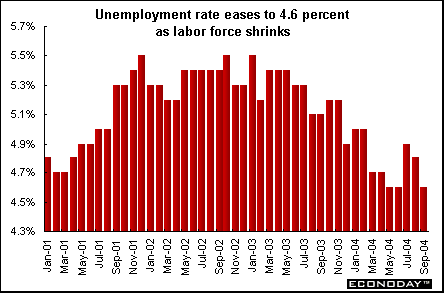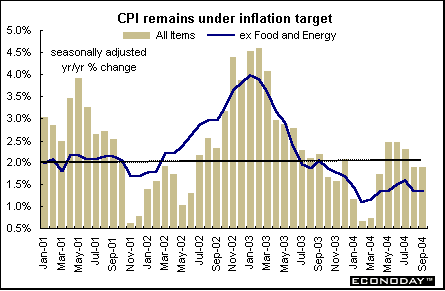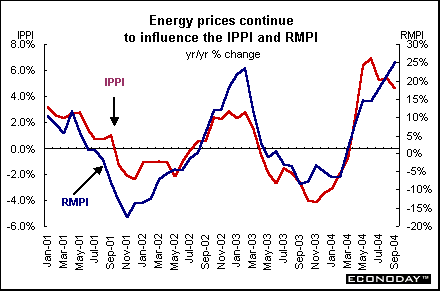Monday, November 1, 2004

Global Markets
Equity markets followed here were clearly �mixed� during October with energy prices seemingly pulling the strings and at times over shadowing earnings reports. The U.S. dollar also bobbed and weaved to the tune of crude prices (see currencies below). On the week, all but the Japanese indexes were up. The Dow - along with the five Asian indexes - are below their September levels. Only the DAX, Dow and Nasdaq are below 2003 levels.
On Friday, markets (excluding Asia/Pacific - they were already closed for the weekend) dipped especially in Europe after U.S. gross domestic product did not meet analysts' expectations. Third quarter GDP was up at an annualized rate of 3.7 percent rather than the anticipated rate of 4.3 percent.
Global Stock Markets

Europe and Britain
The FTSE, CAC and DAX all improved their positions in October. All were up even though they gave ground from early October highs. After soaring over the 4700 mark, The FTSE fell back over 140 points on volatile energy prices, the unfolding insurance scandal and earnings angst to mention but three reasons. However, the FTSE regained its footing and ended the month in the mid-4600s. Investors were concerned that high energy prices would hurt world growth. But when energy prices fell on rising U.S. inventories, investors sold energy company stocks, fearful that lower prices would hurt earnings. Looming large in the background, of course, was the approaching U.S. election. No one wants a repeat of 2000.

European stocks dropped after third quarter U.S. GDP was up at a 3.7 percent annualized rate rather than the anticipated rate of 4.3 percent. The United States is Europe's largest export market and the continent is vulnerable to slower growth there.
Asia/Pacific
While all six Asia/Pacific equity indexes followed here remained above 2003 year-end levels for the second month, five of the six declined in October. The exception was the Australian All Ordinaries, which gained over 3 percent as it climbed to new highs during the month. After ten months the index, up 14.5 percent, is also the best performer of the six, trailed by the Singapore Straits with an increase of 12.3 percent. The Nikkei, Topix and Hang Seng were down every week but the first in October as crude prices weighed heavily on investor sentiment. Then in the final week, China's surprise interest rate increase dampened investor growth expectations. And then there was the usual apprehension ahead of the U.S. election.

In Japan, new economic data by and large disappointed as industrial production declined as did worker household spending. In addition, stocks there were flattened by strong earthquakes and the kidnapping of a Japanese man in Iraq. The main quake, the country's most severe in a decade, was followed by strong aftershocks. Also hurting sentiment were a rising yen, earnings season nerves and the upcoming U.S. presidential election.
On Friday, the Bank of Japan decided to keep its key interest rates almost at zero. It also continued to hold the upper limit of the reserves it makes available to lenders at �35 trillion ($329.6 billion) even though the policy hasn't ended the slide in bank lending that extends back about eight years. The bank said its inflation outlook might be affected by oil prices as well as improvements in productivity that have allowed Japanese companies to hold down wages and employment despite the economic recovery. BoJ Governor Fukui repeated the bank's vow to maintain its zero interest rate policy until the CPI stops falling. A change will also depend on an overall assessment of the economy's health.
Currencies
Although many analysts question whether there is a relationship between oil prices and the dollar, the two have displayed an inverse relationship lately. When crude prices have increased, the dollar has declined. And the dollar hasn't only behaved this way against the euro as illustrated in the graph below, but also against the yen, sterling, Swiss franc and the commodity currencies (Australian and Canadian dollars). Just last Monday the dollar plunged to an eight-year low against the Swiss franc and close to its February low against the euro as crude soared over $55 a barrel. The dollar also dropped to a 12-year low against the Canadian dollar, a six-month low against the yen and a five-month low against the Australian dollar. Against sterling the dollar was at a two-month low.

But there are other issues at play here. The dollar had remained in a tight trading range for much of 2004 before its recent decline. A weaker dollar helps U.S. exporters and helps the United States reduce its huge current account deficit. But the resulting pressure if the dollar continues its decline would probably be felt in Europe. If Asian governments continue with their attempts to avoid significant currency appreciation, the euro would bear the brunt of any dollar drops. This would not bode well for the export-dependent economies of Europe.
Indicator scoreboard
EMU - M3 money supply for the three months ending in September was up 5.7 percent when compared with the same three months in 2003, significantly above the ECB's growth target of 4.5 percent. The ECB has repeatedly warned that excess liquidity could become a worrisome inflation risk once the recovery gains pace.

October flash harmonized index of consumer prices was up 2.5 percent when compared with last year and up sharply from September's reading of 2.1 percent. While no details are provided for flash estimates, the jump was probably due mostly to higher energy prices. The 2.5 percent reading is significantly higher than the ECB's 2 percent inflation ceiling.

EU - October economic sentiment index edged up to 101.3 from 101 in September. Industrial sentiment increased to minus 2 from minus 3 in the previous month while consumer confidence slipped to minus 14 from minus 13. Sentiment improved in retail trade and construction but the service sector was unchanged. While economic sentiment improved in Italy, France and in Germany, it sank in Spain, Portugal, the Netherlands and in Luxembourg.

Germany - October Ifo Institute business sentiment index inched up to 95.3 from 95.2 in September largely due to retail sector improvement. Current conditions edged down to 94.7 from 94.8 in the previous month while expectations were up to 95.9 from 95.7. The business climate was down in manufacturing but up in both retailing and construction.

August revised industrial production was down 1.2 percent from a decline of 1 percent in the original estimate. Excluding construction, output was down 1.2 percent from the originally reported decline of 0.9 percent. Manufacturing declined 1.1 percent rather than the original decline of 0.7 percent. Consumer durable goods output was revised to a drop of 9.9 percent from the originally reported 9.6 percent.

France - September producer price index climbed 0.1 percent and was up 3.1 percent when compared with last year. Excluding food and energy the PPI was up 0.2 percent and 1.9 percent on the year. Energy prices were up 0.6 percent on the month after soaring 1.8 percent in August.

September seasonally adjusted unemployment rate remained at 9.9 percent for the second month. The number of jobless was down by 17,000. France uses the International Labour Organization (ILO) definition which excludes jobseekers who did any work during the month.

Italy - September producer price index was up 0.3 percent and jumped by 3.9 percent when compared with September 2003. The monthly increase was due primarily to increases in both intermediate goods and energy prices. Excluding energy, the PPI was up 0.2 percent and 3.3 percent on the year.

Asia
Australia - Third quarter producer price index was up 1.4 percent and 3.2 percent when compared with the same quarter a year ago. The increase was driven by higher prices for building construction, electricity, gas & water supply and petroleum refining. Manufacturing output prices rose 2.8 percent while manufacturing input prices jumped 7.9 percent in quarter. Both increases were the largest since the fourth quarter of 1990.

Third quarter consumer price index was up 0.4 percent and 2.3 percent when compared with last year. Cheaper food, health care and autos helped offset higher oil prices that have boosted the cost of gasoline and holiday travel. Excluding gasoline, education costs, and fruit and vegetables, the core CPI was up 0.3 percent and 1.2 percent on the year.
Japan - September seasonally adjusted industrial production sank 0.4 percent but was up 3.7 percent when compared with last year. The September decline comes after a tiny 0.1 percent increase in August and a flat reading in July. Electrical machinery dropped 9.6 percent while electrical parts and devices, which include semiconductors, sank 4.1 percent. General machinery declined 2.3 percent.

September seasonally adjusted worker household expenditures dropped 1.1 percent and were unchanged when compared with last year. Spending by Japanese households headed by wage earners rose 0.3% in September in real terms from a year earlier, the government said Friday, suggesting consumer confidence over Japan's economic health hasn't been eroding despite recent signs of moderating growth. Wage-earner household spending is an important gauge of personal consumption, which accounts for roughly 55 percent of Japan's gross domestic product. The seasonally adjusted propensity for wage-earner households to consume, a ratio that measures the amount of disposable income that went to household spending, fell to 71.6 percent in September from 75.4 percent.
October Tokyo consumer price index was up 0.1 percent but was down 0.2 percent when compared with last year. The core CPI, which excludes fresh food, was unchanged on the month and down 0.3 percent on the year. September nationwide CPI was up 0.1 percent but down 0.2 percent on the year. The core CPI was also up 0.1 percent and down 0.2 percent on the year. Corporate goods prices have increased for seven consecutive months to September thanks to higher basic materials, but companies have yet to transfer the higher costs into their final products.

September unemployment rate dropped to 4.6 percent from 4.8 percent in August as workers left the labor force. The labor force shrank by 240,000 people, while jobs declined by 70,000 jobs.

Americas
Canada - September seasonally adjusted consumer price index was up 0.2 percent and 1.9 percent when compared with last year. On an unadjusted basis the CPI was up 0.1 percent and 1.8 percent on the year. Excluding food and energy, the CPI was up 0.3 percent and 1.2 percent on the year. Women's clothing soared 6.2 percent while transportation costs sank 0.7 percent.

September industrial product price index dropped 0.6 percent but jumped 4.6 percent when compared with last year. Petroleum and coal product prices continued to have a major influence on the year, soaring 28.3 percent from September 2003. Excluding petroleum and coal product prices, the IPPI increased only 3.0 percent year-on-year. Primary metal products leapt 21.8 percent from a year ago. Steel products, nickel products and copper products were the major contributors. On the month, motor vehicle and other transport equipment declined 1.3 percent, mainly because of a stronger Canadian dollar. Prices for meat, fish and dairy products fell 3.6 percent as a result of lower prices for beef and veal products.

September raw material price index was up 0.3 percent and 25 percent when compared with last year. This was the largest 12-month gain since June 2000 when raw materials prices surged 27.2 percent. Mineral fuels (up 43.0 percent) and crude oil prices (up 56.8 percent) posted their biggest gains since February 2003. If mineral fuels had been excluded, RMPI would have increased only 11.1 percent instead of 25.0 percent. On the month, mineral fuels were up, as crude oil prices rose 1.5 percent due to continuing supply uncertainties as well as the effect of Hurricane Ivan on inventories. Offsetting the increase in mineral fuels, prices for ferrous materials were down 5.5 percent as a result of lower prices for iron and steel scrap. In addition, non-ferrous metals decreased 1.4 percent as prices for zinc, nickel, silver and lead declined.
In September, the value of the Canadian dollar strengthened against the U.S. dollar, jumping 1.8 percent. If the impact of the exchange rate had been excluded, the IPPI would have slipped just 0.1 percent compared with the actual 0.6 percent decline. On a 12-month basis, if the impact of the exchange rate had been excluded, producer prices would have risen 6.2 percent between September 2003 and September 2004 rather than their actual 4.6 percent increase.
August monthly gross domestic product was up 0.5 percent and 4.6 percent when compared with last year. Both the goods and service producing sectors contributed to this strength. Stronger domestic demand, a build-up of manufacturing inventories, and the end of extended planned shutdowns were behind this growth. Manufacturing sector output jumped 1 percent after a 0.4 percent increase in July. Stronger domestic demand coupled with a build-up of inventories fuelled the increase. Retailing activity was up 1.1 percent following July's 0.4 percent increase. Increased customer traffic was recorded at automotive stores, building & outdoor home supplies stores while computer & software stores reported the strongest growth of all retail trade groups. Convenience, specialty food, beer, wine and liquor stores also showed large increases in sales. However, consumers reduced their spending on clothing and accessories.

Bottom line
Undoubtedly the U.S. national elections will over-shadow all other news next week, and hopefully we will know who will be the next president on Wednesday morning. Markets hate uncertainty and will not look favorably on a hung electorate.
By the way, also on next week's agenda are central bank meetings in Australia, Britain and the EMU. But they will surely not receive their usual quotient of notoriety when they announce their decisions.
Looking Ahead: November 1 through November 5, 2004




